

|
Plykin attractor |
In mathematical theory of dynamical systems a class of uniformly hyperbolic strange attractors is known. In such an attractor all orbits are of the same saddle type, they manifest strong stochastic properties and allow detailed theoretical analysis. In textbooks and reviews, examples of these attractors are traditionally represented by abstract artificial constructions like the Plykin attractor and the Smale - Williams attractor. The simplest attractor of Plykin type is constructed with mapping of a domain of a plane with holes into itself as shown in the picture.

The mathematical theory was advanced more than 40 years ago, but till now the hyperbolic strange attractors are regarded rather as purified image of deterministic chaos than as realistic models of complex dynamics. It would be interesting to have examples of attractors of such type in physics, tecnology, and other fields.
To construct a system with the Plykin attractor let us start with a map of a unit sphere defined as a sequence of four periodically repeating stages of continuous transformations. Duration of each stage is taken to be equal to a unit time interval. The holes will correspond to neighborhoods of four points A, B, C, D on the spere. Let us define the first stage as a flow of the representative points along circles of lattitude away from the meridians AB and DC. The second stage is differential rotation around z-axis with angular velocity depending on z linearly, in such way that the points B and C do not move, while the points A and D exchange their location. The third and the fourth stages are similar to the prevous two, but differ in the spatial orientation: the axes x and z exchange their roles. The picture illustrates the the transformations geometrically, and differential equations for all the stages are written down.
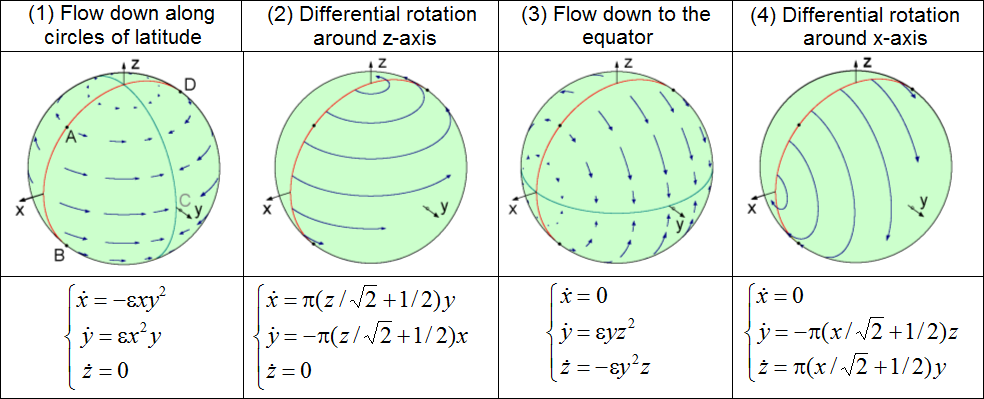
Intuitively, it looks reasonable that this sequence of transformations will generate a flow on the sphere accompanying with formation of filaments of fine transversal structure, presence of which is a characteristic feature of the Plykin type attractors. Transformation of a state after a complete cycle of the stages is determined by a map

At e=1 computer iterations of this map yield the attractor shown in the picture. Observe specific fractal-like transverse structure of the attractor: the object looks like composed of strips, each of which contains narrower strips of the next level etc. In continuous time the evolution of the structure is illustrated by the animation.
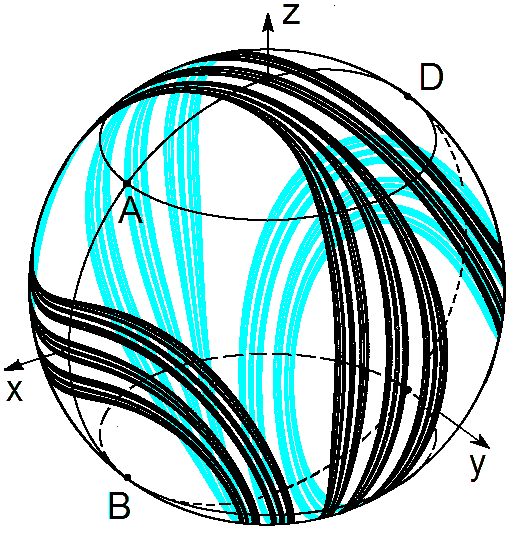
|
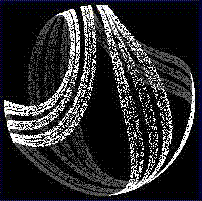
|
From representation on the sphere one can pass to the plane by means of the stereographic projection, with the variable change

It uses the point C as a center, which does not relates to the attractor together with a neighborhood; so, its the image of the attractor occupies a bounded part of the plane. As to the attractor of the flow system, it is disposed in the extended phase space (X, Y, t). Under motion of the sectional plane (X,Y) along the time axis, evolution of the object is illustrated with the animation. It expresses the essence of the hyperbolic nature of the attractor: in the course of the evolution expansion continuously takes place along the filaments and compression transversally to the filament structure.
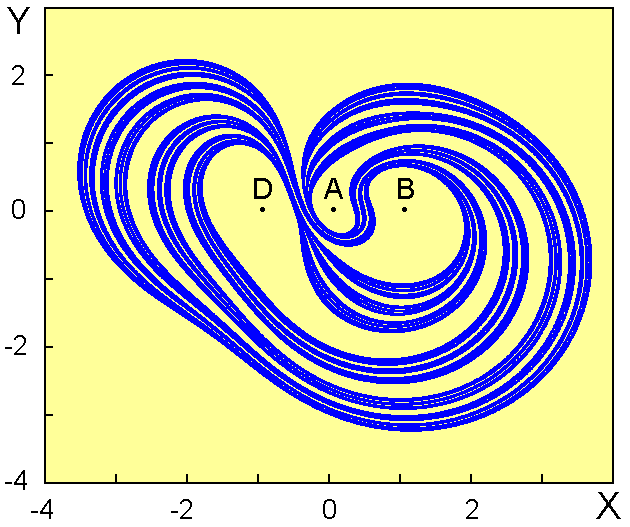
|

|

Accounting structural stability of the hyperbolic attractor, one can try to modify the equations hoping not to destroy the attractor structure; in particular, to pass from the piecewise-continuous in time coefficients to smooth ones. Let us turn to the following equation set in variables on the plane X, Y:

Selecting carefully the parameters, namely, K=1.9, e=0.72, we get an attractor shown in the picture in the three-dimensional extended phase space of the non-autonomous system. In the cross-section t=const observe the object analogous to the attractor of the above map. Computer verification performed for the modified system confirms the hyperbolic nature of the attractor.
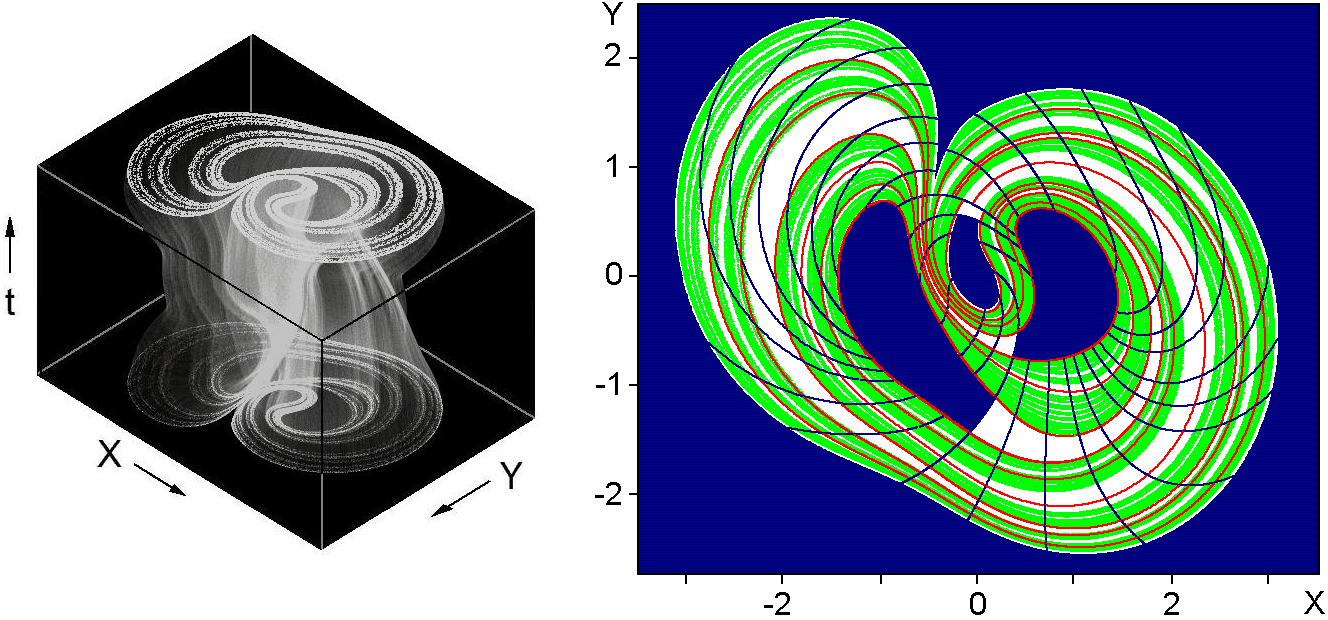
One more argument in favor of the hyperbolicity is a picture of manifolds on the plane (X,Y) in the Poincare cross-section. A domain containing the attractor is shown in white, the attractor itself is green. Unstable manifolds are depicted in red, and stable ones in black. Observe that the unstable manifolds follow along the filaments of the attractor, while the stable ones are transversal to the filaments. Mutual disposition of the stable and unstable manifolds certainly exludes possibility of tangencies.
In the below diagram, Lyapunov exponents are shown against one or another parameter of the system at a fixed value of the second parameter. Intervals are indicated, in which the attractor is found to be hyperbolic in accordance with the computations.
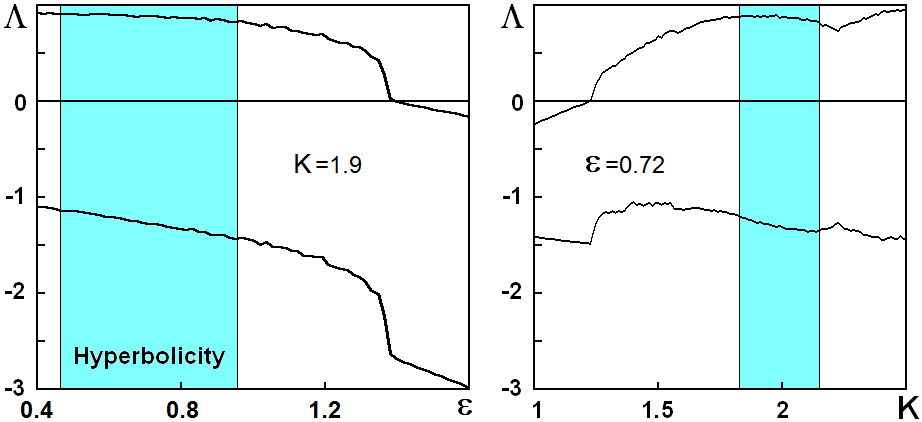
It should be stresset that this is, apparently, the first explicit example of a smooth system possessing a Plykin type attractor in the Poincare map; besides, with the minimum possible dimension of the phase space.
As the equations turned out to be rather cumbersome, it is natural to ask, is their a real possibility to get
the dynamics of such type in some physical device? It appears to be possible with a use of a system of two coupled
non-autonomous oscillators (althouth the phase space dimension is greater).
| Plykin-type attractor in coupled oscillators |
Let us start with a system of two self-oscillators with compensation of losses from the common energy source. Let the equations for the slow amplitudes a and b read

where m is a parameter. Clearly, in sustained regime of self-oscillations, a sum of squared absolute values of the amplitudes is unit; so, ignoring the overall phase, one can identify the instantaneous states with points on the unit sphere. For this, we set

and the Cartesian coordinates are supposed to be expressed via tha angular coordinates with a usial relation

Let us consider the same mapping of the sphere onto itself as earlier, but represent it in six stages for convenience. The stages 1 and 2 will be the same as in the previous construction. The stages 4 and 5 are similar to 1 and 2, but the rotation is of opposite tirection. The additional stages 3 and 6 correspond to simple rotations around the y-axis by 90о. The transformations are illustrated with a picture, where the equations for the complex amplitudes a and b are represented for each stage. Terms responsible for self-oscillations in the original equations are accounted only on the stages of rotation. (Their exclusion for other stages is not so significant, but we do so, because it simplifies derivation of the Poincare map in the explicit form.)
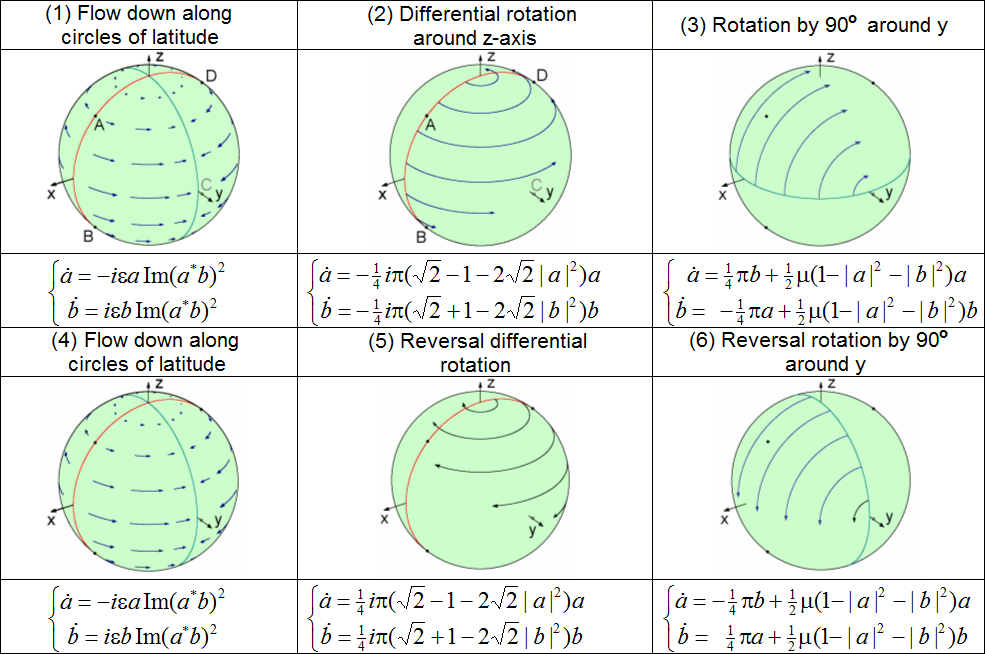
Inroducing the coefficients s and s,
depending piece-wise continuously on time and taking the values

|
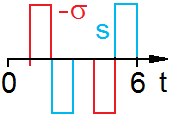
|
The return map associated with transformation of a stane on a perion T=6 may be obtained explicitely. Let initial conditions for the complex amplitudes at t=nT correspond to a state vector Xn=(an, bn). The return map may be represented as a composition of two maps defined for half-periods:

где отображение Fs,s определяется формулами

Figure shows attractor of this map disposed on the sphere. It is obtained at e=1 and m=1. It is the same as drawn in the first section of this web-page. Nevertheless, evolution of the structure in continuous time is distinct, as the sequence of the trensformations on one period has been formulated in a different way.

|
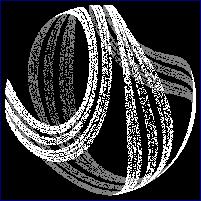
|
Here some computer results are presented relating to the system of coupled oscillators, in particular, the amplitudes of two oscillators versus time in the course of the transient process resulting in appearance of the chaotic regime.

The following two plots show, respectively, the power spectrum for one of the oscillators in the sustained chaotic regime and a phase portrait of the attractor. Angular spherical coordinates are plotted in a horizontal plane. The third variable plotted along the vertical axis is time, within one full period of variation of coefficients in the equations. The picture obviously reminds rising and swirling smoke.

|
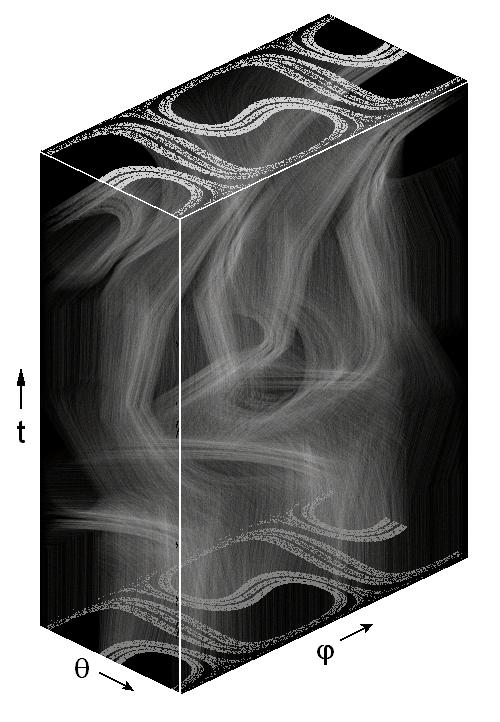
|
Rigorously speaking, in the complex amplitude equations the attractor should not be interpreted as uniformly hyperbolic, because of presence of a neutral direction in the state space associated with the overall phase. Instead, it has to be related to the class of partially hyperbolic attractors. Nevertheless, in the form used here invariance of the equations in respect to the overall phase is exact; it means that dynamics of other variables (amplitudes and a relative phase) is precisely of the same nature as on the actual hyperbolic attractor. However, in systems, for which description in terms of slow complex amplitudes is an approximation, and the break-down of the phase-shift symmetry occurs, one can expect appearance of peculiarities associated with features of the partially hyperbolic attractor. If the deflections from the slow-amplitude approximation are small, one can expect that the dynamics of the basic variables will retain its character because of intrinsic robustness, while the overall phase will manifest slow diffusive-like random walk.
As the systems of coupled oscillators occur in many fields in physics and technology, it is natural to expect that the suggested model may be realizable. Particularly, it may relate to electronic devices, mechanical systems, objects of laser physics and nonlinear optics. The systems with hyperbolic chaos may be of special interest for applications due to their robustness, or structural stability, that means insensitivity of the devices to variations of parameters, characteristics of elements, technical fluctuations, noise etc.